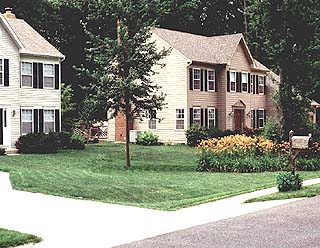
Surveys
DJC.COM
November 15, 2001
Controlling stormwater the natural way
Washington State University

Hinman |
The transition from a forested landscape to a built environment increases impervious surfaces such as roads, parking areas, sidewalk, rooftops and landscaping. Native vegetation and the upper soil layers that evaporate, transpire, store or infiltrate up to 50 percent of our precipitation are typically removed.
Water quality is impaired as stormwater flowing from impervious surfaces collects oil, grease and other pollutants and is discharged to streams, lakes and wetlands.
The quantity and timing of stormwater flows also change dramatically.
Overland flows, shallow sub-surface flows and associated stream discharges increase significantly in the wet winter periods; and stream base flows, maintained by groundwater, decrease during the summer months. Groundwater (about 40 percent of domestic supplies) can be depleted if not recharged during wet periods.
Current stormwater practices efficiently collect and convey precipitation from residential and commercial development to control ponds.
Stormwater control design and maintenance standards often do not protect streams and wetlands from increased water volume discharged from urbanized landscapes. The change in the quantity and timing of stormwater runoff can significantly alter stream channel form. As a result, aquatic habitat and the ability of fish, insects and other stream life to survive are degraded.
The LID approach
Low impact development is a new land development and stormwater management strategy. LID emphasizes protection and use of on-site natural features integrated with engineered, small-scale stormwater controls at the parcel and subdivision scale to manage stormwater and maintain or restore pre-development watershed hydrologic functions.

Photo courtesy of Washington State University This residential development uses open bioswales next to the road to infiltrate and slowly convey stormwater to rain gardens (area with flowers). Notice there are no curb and gutters.
|
Pre-development or natural hydrologic function is the pre-disturbance balance among the overland flow, infiltration, storage, groundwater recharge and evapotranspiration characteristics of the forested landscape predominant in the Puget Sound region.
Low impact development strategies focus on evaporating, transpiring and infiltrating stormwater on site through native soils, vegetation and bioengineering applications, rather than conveying stormwater — at increased volumes — through large structural systems to streams and wetlands.
The goal of low impact development is to generate no measurable impacts to streams from commercial and residential development and to meet new and more restrictive stormwater management standards to protect water quality and salmon listed under the Endangered Species Act.
LID strategies
Managing stormwater with LID strategies requires a comprehensive assessment of the project site to select the appropriate stormwater controls and integrated designs that maximize infiltration and minimize surface runoff.
Some of the essential strategies include:
- Assess the site’s soils, current and native vegetation cover, wetland areas, streams, ponds and other critical areas; and establish buffers and delineate protected areas
- Maximize retention of native vegetation cover to intercept, evaporate and transpire precipitation
- Preserve permeable, native soils and restore disturbed soils with compost and other amendments to infiltrate and store stormwater
- Retain and incorporate topographic site features that promote infiltration and storage of stormwater
- Direct the location of buildings and roads away from critical areas and soils that can effectively infiltrate stormwater
- Minimize building footprints, and road widths and lengths to reduce impervious surfaces; and eliminate effective impervious surfaces
- Utilize pervious surfaces (e.g. pervious pavement, pavers and gravel systems) where possible to promote stormwater infiltration
- Utilize small, decentralized bio-retention areas with appropriate vegetation to infiltrate, store and transpire precipitation
- Reduce the reliance on traditional conveyance and pond technologies to manage stormwater quality and quantity
- Manage stormwater as close to its origin as possible
Much of our focus with LID is to more effectively manage stormwater. Low impact development can and should address other livability issues such as:
- Road design that promotes walking and biking as alternative transportation methods and reduced traffic speeds
- Developing at appropriate densities to meet Growth Management Act goals, and increase access to, and connection between, public transportation modes
- Subdivision layout and building design that promote interaction between neighbors and the connection to open space and recreation
Low impact development focuses on utilizing our most effective stormwater management tools: native vegetation, soils and topography. Appropriately applied, LID can reduce infrastructure needs (e.g. curb and gutters, excessive pavement, and large stormwater ponds).
Initial studies indicate that LID projects can be constructed for the same or below current design standard costs.
Where soil conditions, topography and zoning densities are particularly difficult for stormwater management, LID costs may increase over standard stormwater controls given the higher standard of protection. However, new state stormwater regulations will soon be implemented in Western Washington and will require significantly larger stormwater ponds. As a result, costs for LID and standard management practices will likely equalize on the difficult sites.
The next phase for integrating LID practices into the Puget Sound region is to design and construct well-conceived pilot projects to demonstrate and further monitor these new strategies. Our challenge is to inspire creativity and cooperation among diverse interests for the complex task of implementing low impact development practices that protect water quality and aquatic habitat, and provide livable communities.
Curtis Hinman works for Washington State University as extension faculty and Puget Sound Water Quality field agent.
Other Stories:
- A peek into the architectural process
- Getting a project off the ground
- Head and shoulders above Sea-Tac
- High-rise homes with all the right stuff
- So you’re in it for the money
- What you need to know about your competitors
- Thea’s Landing: Downtown Tacoma’s new urban housing
- Rebirth of a Commencement Bay chateau
- New museum will have Tacomans glassy-eyed
- Beyond the urban core: Learning from the pioneers
- Achieving design certainty through collaboration
- A cap over troubled waters
- Orchestrating Belltown’s rebirth
- Mechanical moxie: Innovations at the new Opera House
- Preserving a church gets personal
- Small housing: A Northwest mini-trend
- Delivering the goods in a tight economy
- Don’t overlook moisture — the silent threat
- Designing a one-building ‘city’ on a Norwegian fjord
- The changing face of retail design
- Preserving affordable housing by design
- Hospitality industry draws on refuge and prospect
Copyright ©2009 Seattle Daily Journal and DJC.COM.
Comments? Questions? Contact us.